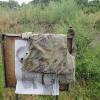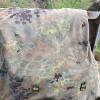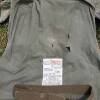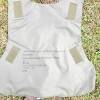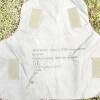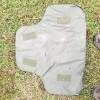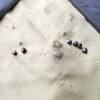I took an old German flak vest I picked up back in the late 90's to the range with me a couple of years ago and shot it a couple of times with both 45acp and 9mm.
Nothing scientific here just wanted to see what was going to happen.
I seem to remember when I got them (had a three or four), these vests, while for "flak", rumor had it, they were also supposed to stop up to a 9mm NATO round, but I dont think they are/were "officially" rated for it.
The panels in the vest look like the basic soft armor panels you see in concealment-type vests. No plates, just soft armor panels. When I cut one open at the end to get the bullets out, there were 15 layers of what looks to be kevlar in them. All told, each panel is about 1/4-3/8" thick.
This particular vest has panels that were made in Germany, but one of the others I had, as I remember, had Second Chance panels in it.
I first threw the vest over the target backer with the back panel flat on the board. The first couple of rounds were 45acp. I meant to bring along some 230 grain fmj, but left them on the counter when I left. What can I say, CRS is setting in.
View attachment 1067499 What youre looking at here, are 200 grain SWC's running at 850fps.
The first rounds were fired at 10yards. The first round, a 45, knocked the vest off the board, and also knocked a big chunk out of the Homasote board.
Same thing happened with the second. Neither penetrated the panel but did tear the inside of the carrier.
I put it back up and the next round I fired was 9mm. One of my 124 grain FMJ reloads running around 1150-1200fps. It too knocked the vest off the backer, and it did penetrate.
It didnt seem like it had enough "solid" behind it, so I laid it flat on the berm for the rest. These were fired from about 5', and I held the guns as perpendicular to the vest as I could. I fired two more 45's and one more 9mm, with the same results. 45's didnt go through, 9mm did.
I then laid the front panel under the back panel I was shooting, to see if it would stop the 9mm. I fired two rounds again from about 5', and neither made it out of the first panel. Nor did they tear the material on the back.
You can see where the round impacted on the second panel, especially on the back, where it was pushed into the ground.
This is the vest hanging on the backer....
View attachment 1067503
Couple of rounds of 45 and one 9mm through the vest. Pretty boring.
View attachment 1067501
View attachment 1067504
Inside of the carrier. Two on the right are 45, and did not go through. One on the left, is 9mm, and it did.
View attachment 1067505
Front of the panel. You can see the info, and if you look close, a couple of holes.
View attachment 1067506
This is just a pic of the front panel. Nothing penetrated it, but it wasnt directly shot.
View attachment 1067507
This is the backside of the front panel, that was under the back panel when it was shot. If you look just below the top edge in the pic, you can sorta see two lighter spots on the panel, in between the toe of my boot, and the piece of velcro at the left. Thats from the bullet impacts into the dirt. The two rounds that made those impacts, stayed in the first panel. (the couple of dark spots that look like holes on the front panel are actually sweat drop impacts. It was steamy the day I shot it, and the sweat balls were flowing free.
View attachment 1067498View attachment 1067500
View attachment 1067508
This is what I got out of the vest when I cut it open. 4 45's and two 9mm's.
View attachment 1067509
This vest is dated 1988. Its 31 years old. Keep in mind too, its also just a "flak" vest, I dont think its "officially" rated for bullets.
While you're always told that they deteriorate with age, and they may well, I think a lot of that depends on how they were used and how they were stored.
Not that this one was really stored "correctly", its just been laying on top of a box in the cellar for about 15 years.












